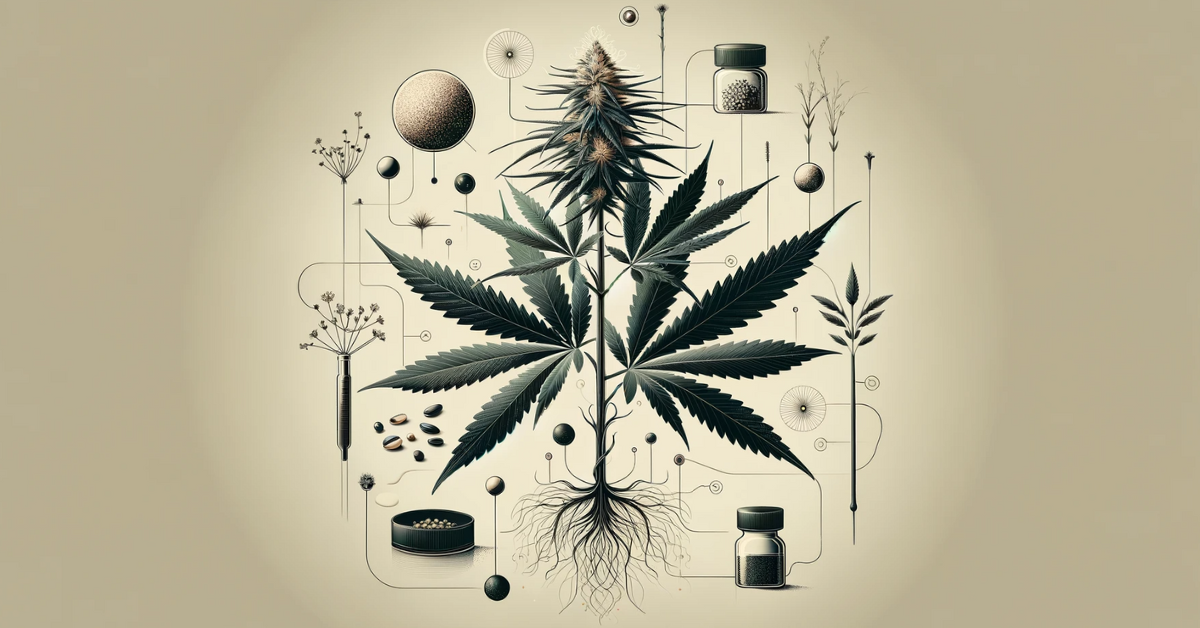Explore the exciting world of cannabis cultivation, where understanding the male and female characteristics of your plants is just as crucial as determining the right harvest time. As experienced cultivators, we know that determining the sex of cannabis plants is not just another step in the process but an essential measure to avoid surprises. In this comprehensive guide, we share our proven methods and experiences in cannabis sex differentiation, offer practical tips to prevent unwanted pollination, and delve into the science behind feminized and regular seeds. Let’s elevate your cultivation knowledge to the next level together!
Chromosome Differentiation
Cannabis is a dioecious plant, meaning there are separate male and female plants. These plants differ by their chromosomes: female plants have XX chromosomes, while male plants have XY chromosomes. This genetic differentiation is fundamental to their reproductive roles and their ability to produce cannabinoids and terpenes. Female plants are especially coveted as they produce the flowers rich in cannabinoids such as THC and CBD, known for their medicinal and psychoactive properties.
The chromosome differentiation plays a crucial role in cannabis breeding, forming the basis for developing different types of cannabis seeds, including feminized and regular seeds. Understanding the genetic structure allows breeders to develop strains adapted to specific light and dark periods to create optimal growing conditions.
During the pre-flowering phase, the plant's sex becomes apparent. Female plants develop pistils, the first signs of flower production, while male plants develop pollen sacs responsible for pollination. This phase is crucial for identifying the sex and removing male plants to maximize the production of female flowers. All these structures are important {{}}.
Types of Cannabis Seeds
Choosing the right type of seed is crucial for successful cultivation:
- Feminized Seeds: These seeds are designed to produce only female plants, eliminating the likelihood of unwanted male plants and maximizing the production of valuable cannabinoids and terpenes.
- Regular Seeds: These seeds can produce both male and female plants, requiring the grower to identify and separate the sexes early to avoid pollination.
The choice between feminized and regular seeds depends on the grower’s goals. Feminized seeds are ideal for those focusing on producing female flowers, while regular seeds offer more genetic diversity and the potential to breed new strains.
Growth Phases
Understanding the growth phases of cannabis is crucial for an optimal harvest:
- Vegetative Phase: During this phase, the plants focus on developing robust roots, stems, and leaves. Proper lighting and nutrient supply are essential to support this growth and build a strong structure for the flowering phase.
- Pre-flowering Phase: A critical time when plants start to show their sex. Early identification and removal of male plants can prevent unwanted pollination of female plants, maximizing flower quality and yield.
During the growth phases, controlling the light and dark periods is important as they can influence the sex of the plants and flower production. A constant light source during the vegetative phase promotes growth, while shifting to longer dark periods triggers flowering.
Identifying Plant Sex

Identifying the sex of your cannabis plants is crucial:
- Female Flowers: Recognizable by the white hairs (pistils) at the nodes of the plant. These hairs are essential for pollen reception and producing flowers with high cannabinoid content.
- Male Flowers: These develop pollen sacs that must be removed to prevent pollination of female plants.
- Hermaphroditic Cannabis Plants: These plants can exhibit both male and female characteristics and should be removed to prevent cross-pollination. Such traits can be triggered by genetic predisposition or environmental factors.
Early sex identification is crucial to prevent pollination of female plants and maximize terpene and cannabinoid production. Growers should regularly inspect the plants to ensure male or hermaphroditic plants are removed in a timely manner.
Effects of Pollination
Pollination has significant effects on cannabis plants:
- Flowers: Pollinated female plants redirect their energy to seed production, reducing the quality and potency of the flowers.
- Signs of Pollination: Swellings in the bracts and color changes in the pistils are clear indications of pollination. These symptoms differ from the natural color changes during the flowering period.
Preventing pollination is crucial to maximize cannabinoid and terpene production and ensure the desired flower quality. Unpollinated female plants produce denser flowers with higher concentrations of active compounds.
Preventing Pollination
Preventing pollination is essential to ensure a high-quality harvest:
- Remove Male Plants: Early identification and removal of male and hermaphroditic plants are essential.
- Separation: Ensure male and female plants are kept apart to avoid accidental pollination.
Using feminized seeds minimizes the risk of accidental pollination, as these seeds only produce female plants. Regular inspections and good organization of the growing area also help prevent pollination.
Dealing with Pollinated Plants
Proper handling of pollinated plants can save your harvest:
- Identification and Removal: Early detection allows growers to remove affected plants and possibly restart the cultivation cycle.
- Consumption: Pollinated flowers can still be consumed, but seeds should be removed to enhance the consumption experience.
While pollinated plants do not offer the same flower quality, they can still be used. Removing seeds is crucial to improving the consumption experience and preserving the flowers’ flavor.
Cloning and Cuttings
For growers looking to preserve specific genetic traits and bypass the complexity of sex differentiation, cloning and cuttings provide reliable solutions. By taking cuttings from a known female plant, you can ensure a harvest without male influence.
Cloning allows growers to cultivate genetically identical plants that retain the desired characteristics of their mother plant. This is particularly beneficial for achieving consistent results and maximizing cannabinoid and terpene production.
Dealing with Hermaphroditic Plants
Hermaphroditic plants can arise due to stress or genetic predisposition:
- Stress-Induced Hermaphroditism: Factors such as light leaks, inconsistent watering, and nutrient imbalances can trigger hermaphroditic traits. Such traits must be identified and addressed early to prevent cross-pollination.
- Genetic Predisposition: Some strains are more prone to hermaphroditism. Choosing stable genetics can minimize this risk and optimize cannabinoid and terpene production.
Managing hermaphroditic plants requires careful monitoring and quick response to maintain the integrity of the crop. Selecting strains with stable genetic predisposition can reduce the occurrence of hermaphroditism and ensure the quality of the harvest.
Important Note:
Successful cannabis cultivation critically depends on understanding and managing plant sex. By using feminized seeds and careful monitoring, you can maximize the potency and quality of your harvest. Always be proactive in caring for your plants to ensure healthy, productive crops.
Conclusion:
Understanding sex differentiation in cannabis plants is key to any successful cultivation endeavor. With the right knowledge and techniques, you can master the complexities of cannabis cultivation and achieve impressive yields. Use this guide as a reference to ensure your cannabis plants reach their full potential.
Disclaimer
This website's content is for informational use only and should not be considered medical or legal advice. Always consult a healthcare professional for health-related issues. Be aware of local regulations regarding cannabis cultivation. We are not liable for any actions taken based on this information.

